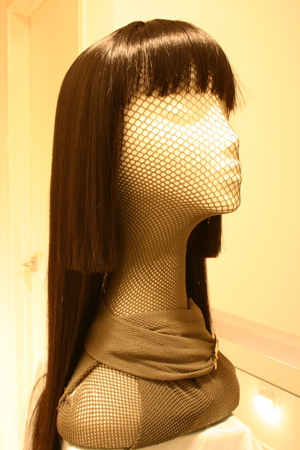
Acrylic paint is a fast-drying paint made of pigment suspended in acrylic polymer emulsion and plasticizers, silicone oils, defoamers, stabilizers, or metal soaps. Most acrylic paints are water-based, but become water-resistant when dry. Depending on how much the paint is diluted with water, or modified with acrylic gels, mediums, or pastes, the finished acrylic painting can resemble a watercolor, a gouache, or an oil painting, or it may have its own unique characteristics not attainable with other media.

A hairstyle, hairdo, haircut, or coiffure refers to the styling of hair, usually on the human head but sometimes on the face or body. The fashioning of hair can be considered an aspect of personal grooming, fashion, and cosmetics, although practical, cultural, and popular considerations also influence some hairstyles.

Hair loss, also known as alopecia or baldness, refers to a loss of hair from part of the head or body. Typically at least the head is involved. The severity of hair loss can vary from a small area to the entire body. Inflammation or scarring is not usually present. Hair loss in some people causes psychological distress.

Human physical appearance is the outward phenotype or look of human beings.

A wig is a head covering made from human or animal hair, or a synthetic imitation thereof. The word is short for "periwig". Wigs may be worn to disguise baldness, to alter the wearer's appearance, or as part of certain professional uniforms.

A merkin is a pubic wig. Merkins were worn by prostitutes after shaving their mons pubis, and are used as decorative items or erotic devices by both men and women.

A jar is a rigid, cylindrical or slightly conical container, typically made of glass, ceramic, or plastic, with a wide mouth or opening that can be closed with a lid, screw cap, lug cap, cork stopper, roll-on cap, crimp-on cap, press-on cap, plastic shrink, heat sealed lidding film, an inner seal, a tamper-evident band, or other suitable means. The English word "jar" originates from the Arabic word jarra, which means an earthen pot or vessel.

A disguise can be anything incognito which conceals one's identity or changes a person's physical appearance, including a wig, glasses, makeup, fake moustache, costume or other items. Camouflage is a type of disguise for people, animals and objects. Hats, glasses, changes in hair style or wigs, plastic surgery, and make-up are also used.

Sausage casing, also known as sausage skin or simply casing, is the material that encloses the filling of a sausage. Natural casings are made from animal intestines or skin; artificial casings, introduced in the early 20th century, are made of collagen and cellulose. The material is then shaped via a continuous extrusion process—producing a single sausage casing of indefinite length—which is then cut into desired lengths, usually while the extrusion process continues.

A toupée is a hairpiece or partial wig of natural or synthetic hair worn to cover partial baldness or for theatrical purposes. While toupées and hairpieces are typically associated with male wearers, some women also use hairpieces to lengthen existing hair, or cover a partially exposed scalp.

Red wine is a type of wine made from dark-colored grape varieties - The color of the wine can range from intense violet, typical of young wines, through to brick red for mature wines and brown for older red wines. The juice from most purple grapes is greenish-white, the red color coming from anthocyan pigments present in the skin of the grape. Much of the red wine production process involves extraction of color and flavor components from the grape skin.

Head shaving is a form of body modification which involves shaving the hair from a person's head. People throughout history have shaved all or part of their heads for diverse reasons including aesthetics, convenience, culture, fashion, practicality, punishment, a rite of passage, religion, or style.
Sam and Friends is an American live-action and puppet sketch comedy television series and a lead-in to The Tonight Show created by puppeteer Jim Henson and his eventual wife Jane Nebel. It was aired live twice daily as a local series in Washington, D.C., on WRC-TV in black and white, and later color, on weeknights from May 9, 1955, to December 15, 1961. However, most of the original episodes were never recorded, and are considered lost. A few surviving episodes can be viewed at the Paley Center for Media but many can also be found on video websites like YouTube, such as those digitally archived by The Jim Henson Company. Some have been documented by either the Henson Archives or newspaper articles published while the show was still on air.
In filmmaking, a pick-up is a small, relatively minor shot filmed or recorded after the fact to augment footage already shot. When entire scenes are redone, it is referred to as a re-shoot or additional photography.

Foundation is a liquid, cream, or powder makeup applied to the face and neck to create an even, uniform color to the complexion, cover flaws and, sometimes, to change the natural skin tone. Some foundations also function as a moisturizer, sunscreen, astringent or base layer for more complex cosmetics. Foundation applied to the body is generally referred to as "body painting" or "body makeup".
This glossary of winemaking terms lists some of terms and definitions involved in making wine, fruit wine, and mead.

Headgear, headwear, or headdress is any element of clothing which is worn on one's head, including hats, helmets, turbans and many other types. Headgear is worn for many purposes, including protection against the elements, decoration, or for religious or cultural reasons, including social conventions.

A regularhaircut in Western fashion is a men's and boys' hairstyle featuring hair long enough to comb on top, with a defined or deconstructed side part, and back and sides that vary in length from short, semi-short, medium, long, to extra long. The style is also known by other names including taper cut, regular taper cut, side-part and standard haircut; as well as short back and sides, business-man cut and professional cut, subject to varying national, regional, and local interpretations of the specific taper for the back and sides.

A makeup brush is a tool with bristles, used for the application of makeup or face painting. The bristles may be made out of natural or synthetic materials, while the handle is usually made out of plastic or wood. When cosmetics are applied using the appropriate brush, they blend better onto the skin.
Scalp reduction is a surgical procedure in which the hairless region of the scalp of a bald person is reduced. This procedure can reduce the area of the scalp in which hair transplantation is needed or even eliminate the need for hair transplantation.
















